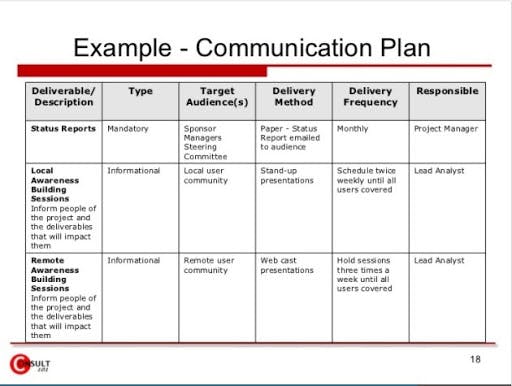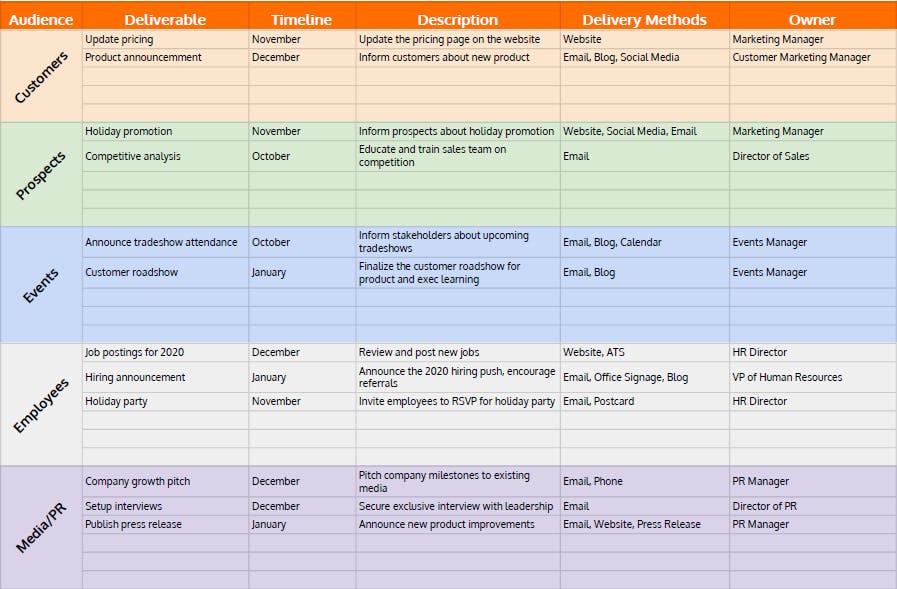Communication plan: approach, examples and best practices
Mar 17th, 2021

Contents
What is a communication plan?
How to write a communication plan
Communication plan examples and templates
Best practices for successful communication plan implementation
People usually follow brands on social media for various reasons. Some companies share valuable information that meets the needs of the target audience. The other brands provide discounts, coupons and organize giveaways. Besides these characteristics, the customers appreciate humorous and funny posts. This content type is one of the most shareable on social media platforms - it gets likes and reposts and expands the brand’s reach. Funny posts create the feeling that your brand is not an emotionless robot but a caring personality. That is why humor, as an engaging tactic within the communication strategy, effectively builds trust and increases brand recognition.
Arena Flowers, the UK-based flower delivery company, used funny posts on Twitter to attract more than 38 000 followers. The comical tweets have been bringing a loyal following since 2011, when the brand implemented this strategy instead of the traditional approach to social marketing. The tweets by Arena Flowers give the impression like you are talking with a friend. Moreover, the posts are written in the first person, which creates a feeling of emotional connection with the readers.


Funny tweets have been a part of Arena Flower’s communication plan for a while, helping the company build a better connection with the customers. So, let’s see how your business can create a similar outstanding communication plan to connect with your unique target audience.
What is a communication plan?
Communication plan is a strategy used by a company to reach the target audience and inform people about the brand’s product, service, goals, or future actions. It defines the main message to be communicated, the target audience it needs to reach, and a strategy of how your message would be delivered to the selected audience. So, a communication plan includes three components: the message, the medium, and the target.
The traditional communication plan typically covers the company’s current situation, business goals, audience, core messages, preferred channels, calendar, and the criteria to assess progress. There are two major types of communication plans: external and internal. External communication plan is addressed to the clients, the general public, governmental agencies, or company investors. Internal communication plan is targeted towards all organization’s employees, or groups of them, like employees within one location or department.
External communication plan
External communication aims to connect with the audience outside of your business and share your brand purpose, personality, and developments. While marketing plans are focused on conveying value to customers, an external communication plan speaks to a broader audience with the help of various methods like presentations and investor campaigns. Brands use different platforms to communicate with the public, customers, and partners, including websites and blogs, conferences and live events, email, social media, and press releases. The other ways to connect with the audience are advertising and networking with PR agencies and influencers.
Internal communication plan
An internal communication plan is a blueprint that defines your business objectives in communication with employees and determines the activities needed to achieve the goals. An excellent internal communication plan usually contains updates on progress towards business goals, team accomplishments, and information about the company’s changes. The employees can also share their thoughts and suggestions regarding improvement. The company can communicate with employees through meetings, social media posts, intranet messages, videos, or emails.
How to write a communication plan
Step 1. Perform a situation analysis
The first and one of the essential steps is to assess the company’s current state of communication. To perform a situation analysis for an internal communication plan, you need to consult staff members and head departments. The research for an external communication plan requires sending surveys to your target audience or organizing focus groups. The situation analysis should contain your organization’s focus and goals, strengths and weaknesses, culture, and your target market’s assessment.
To conduct an audit of the gaps in your overall communication, you can use several techniques. These methods allow for the analysis of both external and internal environments.
- SWOT analysis helps determine your business’s strengths and weaknesses, threats, and opportunities in the external environment.
- PEST-analysis is useful for analyzing political, economic, social, and technological factors that exist outside of your company but impact your business.
- A perceptual map allows for an understanding of how your customers evaluate your competitors in the market.
Step 2. Define the objectives
After you analyze the current state of your communication activities, you can proceed to the next step and identify the objectives. You need to think of the outcomes you want to achieve with a communication plan. Each goal set by your team should align with these objectives. The most effective approach to setting objectives is SMART-method. It implies that the objective should be specific, measurable, attainable, relevant, and time-based.
For instance, some of your company’s objectives might be motivating people to improve results, generating interest in the product, and creating a dialogue between employees and stakeholders. An example of a SMART goal might be “to increase brand awareness by 10% over the next year”.
Step 3. Develop/review a brand statement and USP
To communicate your value to the audience, you need to understand who you are and what benefits you can provide to the customers. This will be your brand statement. The template of your brand statement may be as follows: Our company provides [benefits] to [the audience] through [product or service].
Also, effective communication requires a thorough understanding of your unique selling proposition or USP. In other words, you need to find out what makes your brand different from your competitors. What brings particular and unique value to your customers, which they will not receive from any competitor on the market? To identify a unique selling proposition, you should answer the questions:
- What makes your brand unique?
- What do you have that your competitors don’t?
- What is difficult to copy in your products?
Step 4. Identify the key audience
The next step is to develop customer personas and understand the target audience you are trying to reach. The key audience of your communication plan could be your customers, employees, or stakeholders.
You need to gather data about customers’ values, interests, opinions, lifestyles, ages, gender, nationalities, income, and education. Then you will be able to create three simple customer personas you want to attract, taking into account these characteristics.
To perform the customer analysis, you can use Google Analytics to understand the behavior tendencies and interests of your website visitors; conduct surveys using Google Forms or Survey Monkey (or do it in person); hold research interviews with existing or potential clients, which constitute your target audience. Additionally, you can conduct research into competitors and their clients, which might provide additional information for insights. For example, you can compare your competitors’ social media followers to your own to see what they are looking for in a company.
Step 5. Determine the channels to deliver your messages
The following step in your communication plan is to choose the channels to share your message on. The choice will depend on your message and target audience. Often, you may need to use distinct approaches to deliver your message to different audience segments.
The channels might include your company blog, social media, emails, SMS marketing, and traditional advertising. For example, it is better to use email newsletters or press releases for external communication with stakeholders and investors. At the same time, social media and traditional advertising may be better channels to communicate with your customers.
Step 6. Connect your business with the audience
Once you collect the information on who you are, what makes your brand unique, and who your target audience is, you are ready to move on to the next step. Now it is time to figure out the message and the story you will tell the world. Think about the answers to the following questions:
- What are the essential facts people need to know about your brand?
- What are the common misconceptions about your brand that you need to dispel?
Step 7. Create the messaging matrix
This step is a sum of the results of the previously listed actions. The messaging matrix is a document that contains your brand statement, target audience, core problem you solve for the customers, and critical messages. This chart summarizes your values, what makes you different from competitors, and your unique value proposition. It is essential to create the messaging matrix because it will keep your team on the same page, make copywriting easier, and keep the content focused on the customer journey.
Step 8. Determine the essential events and estimate the amount of time for each stage
You need to consider the amount of time required for executing each step of the communication strategy. Pay attention to important events throughout the year to align them with campaign plans. These might be holidays, conferences in your industry, seasonal sales cycles, etc. Create a content calendar that helps you to determine how often your audience will hear your message.
Step 9. Establish a budget
Building a budget will help calculate the costs of investing in expensive communication methods such as mass media or paid advertising. It is essential to calculate the overall costs for the communication plan and leave room for an emergency.
Step 10. Measure the results and identify areas for improvement
Review the communication plan and identify the areas for improvement during and after its implementation. Consider whether people received your message and analyze how they responded. Before implementing the project, you should determine the date of the review and the criteria to decide whether each communication method was effective.
Communication plan examples and templates
Communication plan for stakeholder engagement

This is an example of an internal communication plan directed at the company’s stakeholders. It includes the type of communication, target audience, channels, timetable, and people responsible for delivering the message. The main aim of this communication plan is to raise people’s awareness of the project.
The delivery methods of this communication plan are chosen, taking into account that the target audience is the steering committee, sponsor, managers, local and remote user communities. Accordingly, delivery methods include live presentations, online events, emails, and papers. The responsible persons who will deliver the message are a project manager and lead analyst.
External communication plan with multiple target audiences

This communication plan template includes various types of target audiences, both internal and external. It contains important events and a timeline for each situation.
The delivery methods include mainly online ways of communication, such as blogs, emails, websites, and social media. The communication with the employees includes print-based media like postcards and office signage and an applicant tracking system. The company will communicate with PR agencies via phone and press releases. Besides the regular events like product improvements announcement, the creators of the plan scheduled holiday party, roadshow, and tradeshow.
External communication plan with customers and partners

The external communication plan by IndTex is focused on improving the company’s image and promoting collaboration with other organizations. The communication channels for these goals include print media, newsletters, and participation in conferences.
The target audience of the external plan is customers, purchasers, local government, and stakeholders, including business associations. The means of communication with the external audience are print media, newsletters, conferences, and the company’s homepage. The company did not establish any fixed schedule for communication. The criterion is the achievement of the goals. The responsible person is the marketing manager and PR department.
Best practices for successful communication plan implementation
The communication plan is important to clarify your company’s objectives, to make sure your message reaches your target audience, and to discover the most effective ways to communicate with them. Here are a few more things you need to consider to make sure you succeed.
Consistent and frequent communication. When creating your internal or external communication plan, ensure that there is an open dialogue between your team members. It is needed to build trust within your team and improve motivation.
Metrics and progress analysis. Measure the results and use metrics to track the progress of the team’s work. To maximize the productivity of the organization, provide rewards for staff members for an excellent performance.
Communication transparency. Transparency is one of the most crucial practices in the organization. Share industry news and trends and motivate the employees to provide honest feedback and ideas regarding the products, methods, and working procedures. Encourage collaboration across departments.
A successful communication plan will translate your brand into the right message for the target audience. If you improve the internal communication within the organization, your employees will be more productive, which leads to the higher profitability of the company. Follow these ten steps, and you will improve the collaboration within your organization and the performance of your business.
